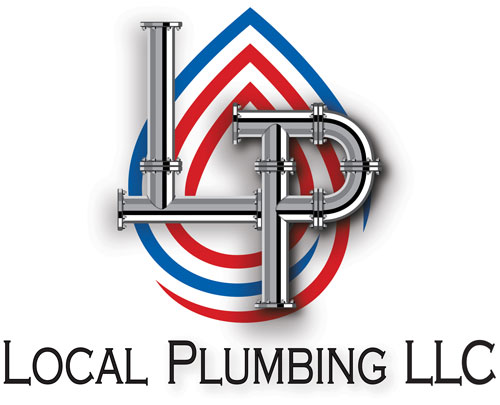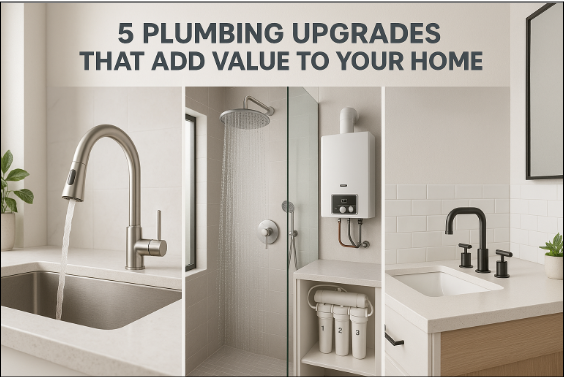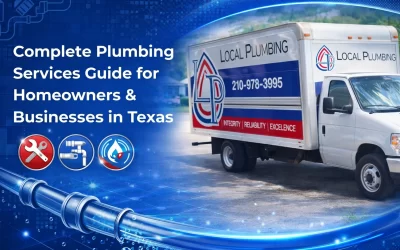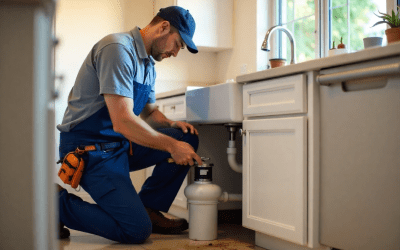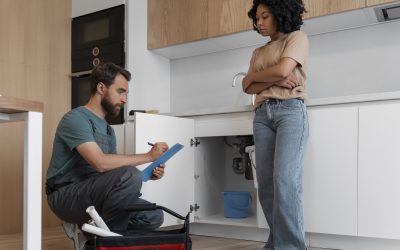When it comes to boosting your home’s value or enhancing it for your own comfort, many people focus on paint colors or kitchen remodels. Plumbing upgrades often fly under the radar, until something goes down. Yet, simple improvements to your pipes, fixtures, and water systems can make a big difference not just in functionality, but also in resale appeal. From modernizing faucets to upgrading your water heater, these changes signal to potential buyers that your home is well-maintained and efficient. Plus, energy- and water-saving upgrades can lower utility bills, which is always great for your own convenience.
In this blog, we’ll explore five such key plumbing upgrades, along with discussing specific problems each upgrade solves and why they are worth considering.
Upgrade 1 – Replace Old Pipes with Durable Alternatives
Older homes often have plumbing systems composed of materials that degrade over time, such as galvanized steel or polybutylene. Replacing these pipes with durable alternatives like PEX, copper, or CPVC can significantly improve water quality, system reliability, and overall home safety.
Problems Solved:
Corrosion
Corrosion is a common issue in older metal pipes, especially in homes with high mineral content in water. It causes rusty water, weakens pipes, and increases the risk of leaks. Replacing corroded pipes with these resistant materials, such as PEX, CPVC, copper, or stainless steel, prevents future deterioration and improves water quality.
Fractures
Over time, pipes can develop fractures due to pressure changes, shifting foundations, or natural wear. Even small cracks can cause leaks, water damage, and mold growth. Durable pipe replacements eliminate these vulnerabilities, providing long-term reliability.
Electrolysis Damage
Electrolysis occurs when two different metals in plumbing systems interact, accelerating corrosion. This chemical reaction can silently weaken pipes, leading to unexpected failures. Upgrading to compatible materials prevents electrolysis and extends the lifespan of your system.
Pipe Collapse
Older materials, especially polybutylene, are prone to collapse under pressure, causing major plumbing failures. Switching to modern alternatives ensures your plumbing system can withstand daily demands without risk of structural failure.
Delamination
Plastic pipes sometimes suffer from delamination, where the inner layers separate, reducing water flow and increasing the chance of leaks. Modern materials with uniform construction eliminate this problem, ensuring consistent water delivery throughout your home.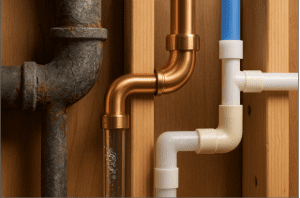
Upgrade 2 – Install Water-Efficient Fixtures
Water-efficient fixtures are not only environmentally friendly but also reduce utility bills and decrease strain on your home’s plumbing. Replacing faucets, showerheads, and toilets with modern plumbing fixtures can have a substantial impact on both water conservation and system longevity.
Problems Solved:
Erosion
Traditional fixtures with high flow rates can accelerate pipe erosion. Over time, this leads to leaks, pitting, and structural damage. Installing low-flow showerheads, aerated faucets, and modern toilets reduces water velocity, minimizing wear and tear inside your plumbing system.
High Water Consumption
Older fixtures like standard toilets, conventional faucets, and outdated showerheads can waste significant amounts of water. Dual-flush toilets, low-flow faucets, and water-saving showerheads lower overall water consumption, reduce utility bills, and support sustainable living practices.
Strain on Aging Pipes
High-pressure fixtures, such as traditional garden hoses, old showerheads, or pressure-intensive faucets, can put undue stress on aging pipes, especially if corrosion or mineral buildup is present. Modern pressure-balanced faucets, low-flow showerheads, and regulated hose bibs maintain appropriate water pressure, reducing strain and extending the life of your plumbing network.
Increased Risk of Pressure Damage
Excessive water pressure can cause burst pipes, joint failures, and leaks, especially in older or weakened plumbing systems. Pressure-reducing valves control water pressure throughout your home, while water-efficient fixtures such as low-flow faucets and showerheads help relieve stress on pipes. These measures protect your plumbing from pressure-related damage, extend the system’s lifespan, and conserve water, lowering both maintenance costs and utility bills.
Upgrade 3 – Add a Modern Tankless Water Heater
Traditional water heaters take up space, waste energy keeping a large tank of water hot, and often wear out faster due to constant use. A modern tankless water heater, on the other hand, heats water only when needed, delivering a continuous supply of hot water without the standby energy loss. This results in lower utility bills and precise temperature control. It also reduces the risk of leaks and requires minimal maintenance.
Problems Solved:
Thermal Expansion Damage
Pipes connected to tank-based water heaters are prone to thermal expansion, which can stress joints and trigger leaks. Switching to a tankless system heats water on demand, preventing sudden pressure changes and protecting the plumbing network.
Overheating of Pipes
With traditional water heaters, water can become excessively hot, increasing the risk of pipe damage and scalding. Tankless systems maintain precise temperature control, safeguarding your pipes and enhancing household safety.
Energy Inefficiency (related to pipe system lifespan)
Conventional heaters keep a full tank of water constantly heated, wasting energy and placing extra stress on pipes. A tankless water heater only heats water when needed, conserving energy and reducing wear on the plumbing system.
Leaks from Traditional Water Heaters
Over time, tank-style water heaters may develop leaks, causing potential water damage. Modern tankless designs are compact with fewer components, lowering the chances of leaks and improving overall system reliability.
Upgrade 4 – Set Up a Whole-House Water Filtration System
A whole-house filtration system removes sediments, minerals, chlorine, and other contaminants from every tap, protecting pipes and appliances. Systems with activated carbon, sediment, and UV or reverse osmosis filters improve water quality, extend plumbing lifespan, and ensure safe, clean water for your family.
Problems Solved:
Scaling or Mineral Build-Up
Hard water causes scaling in pipes, reducing water flow and efficiency. Filtration prevents mineral buildup, ensuring smooth operation and extending pipe life.
Contaminant-Driven Corrosion
Certain chemicals and contaminants accelerate corrosion in metal pipes. Filtration removes these harmful elements, preserving pipes and preventing premature failures.
Sediment Clogging
Sediment from municipal or well water can settle in pipes, clogging fixtures and appliances. A whole-house filtration system prevents sediment accumulation, reducing maintenance needs.
Joint Failures from Mineral Crust
Mineral crust can cause leaks at pipe joints, especially in high-pressure areas. Filtration minimizes deposits, protecting connections and maintaining system integrity.
Pipe Blockages
Debris, rust, and minerals contribute to blockages over time. Proper filtration keeps water clean and pipes clear, reducing the likelihood of emergency plumbing repairs.
Upgrade 5 – Install a Smart Leak Detection System
A smart leak detection system monitors your plumbing in real time and alerts you immediately if it detects leaks, drips, or unusual water flow. By identifying problems early, these systems prevent extensive damage, reduce repair costs, and give homeowners peace of mind while protecting the integrity of their home and plumbing network.
Problems Solved:
Undetected Leaks
Small leaks often go unnoticed until significant damage occurs. Smart detectors alert you immediately, allowing for timely intervention.
Burst Pipes
A sudden pipe burst can flood a home and damage valuable property. Early alerts from a leak detection system minimize water loss and structural damage.
Pinholes
Pinholes in pipes develop slowly, leading to continuous water leakage. Smart detection systems identify these weak points before they escalate into major problems.
Water Damage from Slow Leaks
Slow leaks are deceptively destructive, causing mold growth and damage over time. Immediate alerts enable homeowners to take action before extensive harm occurs.
Final Thoughts
Plumbing may not be the first thing homeowners notice, but it plays a crucial role in comfort, safety, and property value. Replacing worn pipes, installing modern fixtures, and incorporating smart technology not only prevent costly repairs but also make everyday life more efficient. At Local Plumbing, LLC, we specialize in reliable, high-quality plumbing upgrades tailored to your home’s needs, ensuring long-lasting performance, enhanced safety, and increased value for your property. Optimize your home’s plumbing today with us for the safety and value of your home. Contact us at (210) 978-3995 for a consultation!
